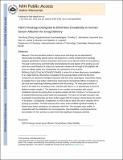Pt(IV) Prodrugs Designed to Bind Non-Covalently to Human Serum Albumin for Drug Delivery
Author(s)
Suntharalingam, Kogularamanan; Yoo, Hyunsuk; Lin, Wei; Brooks, Jamar G.; Lippard, Stephen J.; Zheng, Yaorong; Johnstone, Timothy; ... Show more Show less
DownloadLippard_Pt IV prodrugs.pdf (705.1Kb)
PUBLISHER_POLICY
Publisher Policy
Article is made available in accordance with the publisher's policy and may be subject to US copyright law. Please refer to the publisher's site for terms of use.
Terms of use
Metadata
Show full item recordAbstract
Albumin is the most abundant protein in human serum and drugs that are administered intravenously inevitably interact with it. We present here a series of platinum(IV) prodrugs designed specifically to enhance interaction with human serum albumin (HSA) for drug delivery. This goal is achieved by asymmetrically functionalizing the axial ligands of the prodrug so as to mimic the overall features of a fatty acid. Systematic variation of the length of the aliphatic tail tunes the cellular uptake and, consequently, the cytotoxicity of cis,cis,trans-[Pt(NH[subscript 3])[subscript 2]Cl[subscript 2](O[subscript 2]CCH[subscript 2]CH[subscript 2]COOH)(OCONHR)], 4, where R is a linear alkyl group. Investigation of an analogue bearing a fluorophore conjugated to the succinate ligand confirmed that these compounds are reduced by biological reductants with loss of the axial ligands. Intracellular release of cisplatin from 4 was further confirmed by observing the characteristic effects of cisplatin on the cell cycle and morphology following treatment with the prodrug. The most potent member of series 4, for which R is a hexadecyl chain, interacts with HSA in a 1:1 stoichiometry to form the platinum-protein complex 7. The interaction is non-covalent and extraction with octanol completely removes the prodrug from an aqueous solution of HSA. Construct 7 is robust and can be isolated following fast protein liquid chromatography. The nature of the tight interaction was investigated computationally, and these studies suggest that the prodrug is buried below the surface of the protein. Consequently, complexation to HSA is able to reduce the rate of reduction of the prodrug by ascorbate. The lead compound from series 4 also exhibited significant stability in whole human blood, attributed to its interaction with HSA. This favorable redox profile, in conjunction with the established nonimmunogenicity, biocompatibility, and enhanced tumor accumulation of HSA, produces a system that holds significant therapeutic potential.
Date issued
2014-06Department
Massachusetts Institute of Technology. Department of Chemistry; Massachusetts Institute of Technology. Department of Electrical Engineering and Computer ScienceJournal
Journal of the American Chemical Society
Publisher
American Chemical Society (ACS)
Citation
Zheng, Yao-Rong, Kogularamanan Suntharalingam, Timothy C. Johnstone, Hyunsuk Yoo, Wei Lin, Jamar G. Brooks, and Stephen J. Lippard. “Pt(IV) Prodrugs Designed to Bind Non-Covalently to Human Serum Albumin for Drug Delivery.” Journal of the American Chemical Society 136, no. 24 (June 18, 2014): 8790–8798.
Version: Author's final manuscript
ISSN
0002-7863
1520-5126